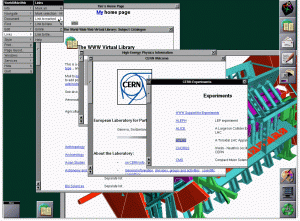Value and price
History, when viewed closely, can look quite mundane.
Twenty years ago this week, a short document was released by CERN, the European research centre – builders of the Large Hadron Collider. It was a simple, dull document. But on page 2 there was a short paragraph that changed everything.
“CERN relinquishes all intellectual property to this code, both source and binary form and permission is granted for anyone to use, duplicate, modify and redistribute it.”
They were talking about the rights to software code that drove a new way for computers to talk to each other. They were talking about the World Wide Web.
Tim Berners-Lee’s baby was not going to be patented. It was being set free for anyone to use and create with. This was hugely significant. Anyone could now run with this brilliant new idea – add to it, use it, improve it, all without cost. Berners-Lee could have been Bill Gates. But he became something far, far more inclusive. And we all owe him for that.
How significant was this little document? I suggest it’s the reason you’re reading this document now. And the reason you’ve been able to access these words so easily, on such a variety of browsers and devices, wherever you are in the world.
The web is the paper of the Internet. The presentation screen to the global conversation. Could it have thrived with private patenting? Maybe. Eventually. In some limited, walled-garden, proprietary ‘iTunes’ way. But not like it is now. Not as game-changing, ubiquitous and globally-accessible.
The big stuff that changes our world is very rarely researched and developed without some public investment, and rarely thrives without the collaborative spirit of scientists and technologists. These are things that make the intangible into a real benefit. It’s impossible to cost in the short-term, but becomes priceless over time.
Interestingly, the Arts works in just the same way. Two weeks ago, UK Culture Minister Maria Miller made a speech advising that the Arts must ensure future funding by focusing primarily on economic, not artistic, value. She said that Arts must ‘demonstrate the healthy dividends that our investment continues to pay.’ This sentence contains troubling emphasis. The idea of public “funding” is expressed as “investment.” Funding is a self-evident endowment – but an “investment” suggests a conditional arrangement with a requirement for a tangible return – “dividends,” as Miller calls it.
Yet is this how art, or indeed science, works? Art, like science, trades in the quality and breadth of ideas. The intangible. Transformed ultimately into multi-billion pound contributions to GDP – but not explicitly framed to do so.
Even Miller’s own government department acknowledges this. The creative industries in the UK contribute a massive 10% of all exports, and employ millions. [UPDATE 7th May 2013: A report issued in the UK by the Centre for Economics and Business Research (CEBR) confirms that UK Arts delivers four times its public subsidy in contribution to GDP]. Likewise, scientific innovation in the UK contributes to 30% of GDP, yet government investment is smaller than all of its industrial competitors (see here). The problem is, it is impossible to ‘reverse-engineer’ the subsequent financial success of art and science to provide a reliable template for future financial ‘dividend.’ Just like it was impossible to anticipate that what Tim Berners-Lee invented to make arcane documents accessible to CERN researchers in Switzerland would eventually disrupt the global newspaper, music, book publishing and movie industries.
An essential ingredient to all creativity in art and science is the idea that one shares something to gain far more. That’s not an ‘investment’ in the financial sense. It’s an act of trust in the commonwealth of ideas in culture – and an acknowledgement of the power of what one cannot yet see. It’s the best of who we are, or should be.
It’s the crucial difference between value and price.

Small aside: the contribution of the World Wide Web to society may be invaluable and life-changing, but could the “price” lie in the new developments – that, granted, TB-L would probably not be able to foresee – such as cyber-bullying/net-hating, loss of a certain level of privacy, and techno-dependency? But yes, I hear what you are saying with regards to the industrialisation of knowledge.
Hi – thanks for the reply. I think this is a really good point. We shouldn’t see technological developments – or indeed any scientific or artistic developments – as wholly “good”. Just as we shouldn’t see them as wholly dangerous or negative. This, for me, is part of the old modernist myth about progress. We can certainly be more nuanced about the effect of tech outcomes on our society, as the intangible nature of creative applications can lead to unforseen positive and negative results. However, acknowledgement of the clear value inherent in creative collaboration and openness – and its contribution to our civilisation – does not preclude the possibility of unwanted effects. Yet I would suggest that those effects you mention – cyber-bullying/net-hating, loss of a certain level of privacy, and techno-dependency – are behaviours born in us as a society, rather than in machines. We must be careful not to blame the paper for the poison written on the page.
Oh yes. The WWW is a tool, and we have all heard the one about the poor workman.
Interesting peice.
Science and the arts are driven by passion. The dividends of passion are inspiration and creativity, neither of which can be measured in one lifetime.